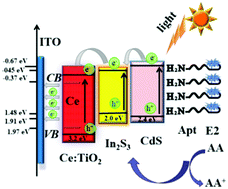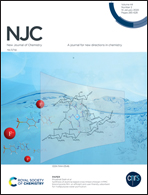A photoelectrochemical aptasensor for the detection of 17β-estradiol based on In2S3 and CdS co-sensitized cerium doped TiO2†
Abstract
In this work, a photoelectrochemical (PEC) aptasensor for the detection of 17β-estradiol (E2) based on an In2S3 and CdS co-sensitized cerium (Ce) doped TiO2 (Ce:TiO2) electrode was constructed successfully. In2S3 with superior properties, such as narrow band gap, attractive photoelectric conversion efficiency, hypotoxicity and low pollution, could act as a promising material in the PEC sensing detection field. Here, a PEC aptasensor based on In2S3 was fabricated for the detection of E2. Besides, Ce doped into TiO2 introduced a new intrinsic energy band into TiO2, which created an easier electron transfer path. In2S3 and CdS co-loaded on Ce:TiO2 not only improved the photocurrent response but also expanded the light absorption range. Meanwhile, an aptamer with a specific sequence, serving as a recognition unit, was used to specifically bind with E2 to enable detection. Under optimal conditions, the as-prepared aptasensor exhibited a linearity range of 10−5–100 ng mL−1 with a detection limit of 4.0 fg mL−1. The aptasensor also showed satisfactory selectivity, stability and acceptable reproducibility.



 Please wait while we load your content...
Please wait while we load your content...